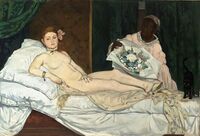Difference between revisions of "Pleasant feeling painting"
Bowserbros (talk | contribs) |
Bowserbros (talk | contribs) |
||
| Line 31: | Line 31: | ||
==Real-world information== | ==Real-world information== | ||
| − | |||
[[File:Olympia.jpg|thumb|left|200px|''Olympia'']] | [[File:Olympia.jpg|thumb|left|200px|''Olympia'']] | ||
| + | Painted in 1863 and first exhibited at the Paris Salon two years later, Manet's ''Olympia'' scandalized audiences with its depiction of the title character, whose confrontational gaze and visual allusions to prostitution portrayed female sexuality with an unprecedented and unrepentant frankness. While the painting had countless precedents, its style further betrayed the norms of its era and allowed the work to stand more on its own through its coarser appearance: its broad strokes, minimal tone and depth, and depiction of an unusually thin body type mesh with its deviant imagery and altogether move it away from the contemporary idealization of women in favor of a grittier and more down-to-earth portrayal of femininity. Furthermore, the model for ''Olympia'', {{wp|Victorine Meurent}}, was a well-known figure in Paris as both a model and an accomplished artist in her own right, compounding the scandalous imagery by consensually attributing it to someone who was not only a real contemporary figure, but a famous one at that. | ||
| + | In the centuries since its debut, ''Olympia'' has continued to stoke controversy among audiences, not only for its portrayal of femininity but also for the depiction of the title character's maid, who modern scholars argue reflects lingering anti-black prejudice in French society during Manet's lifetime. | ||
{{Clear}} | {{Clear}} | ||
Revision as of 18:24, April 19, 2021
| ||||||
| Real-world counterpart | ||||||
|---|---|---|---|---|---|---|
| Olympia | ||||||
| Year | 1863 | |||||
| Artist | Édouard Manet | |||||
| Main appearances | ||||||
|
| ||||||
Name in other languages
いいかんじのめいが
N/A N/A N/A
N/A
N/A N/A N/A
N/A N/A N/A N/A | ||||||
The Pleasant Feeling Painting (unofficial translation)[nb 1] is a painting in Doubutsu no Mori and Doubutsu no Mori+. It is based on Édouard Manet's Olympia.
Art details
In Doubutsu no Mori+
The Pleasant Feeling Painting is replaced by the Classic Painting in Animal Crossing, which shares the same internal hexadecimal ID.
Real-world information
Painted in 1863 and first exhibited at the Paris Salon two years later, Manet's Olympia scandalized audiences with its depiction of the title character, whose confrontational gaze and visual allusions to prostitution portrayed female sexuality with an unprecedented and unrepentant frankness. While the painting had countless precedents, its style further betrayed the norms of its era and allowed the work to stand more on its own through its coarser appearance: its broad strokes, minimal tone and depth, and depiction of an unusually thin body type mesh with its deviant imagery and altogether move it away from the contemporary idealization of women in favor of a grittier and more down-to-earth portrayal of femininity. Furthermore, the model for Olympia, Victorine Meurent, was a well-known figure in Paris as both a model and an accomplished artist in her own right, compounding the scandalous imagery by consensually attributing it to someone who was not only a real contemporary figure, but a famous one at that.
In the centuries since its debut, Olympia has continued to stoke controversy among audiences, not only for its portrayal of femininity but also for the depiction of the title character's maid, who modern scholars argue reflects lingering anti-black prejudice in French society during Manet's lifetime.
Notes
- ↑ As no officially localized English name exists for this subject, it was given an unofficial translation that accurately represents the original text (いいかんじのめいが).

